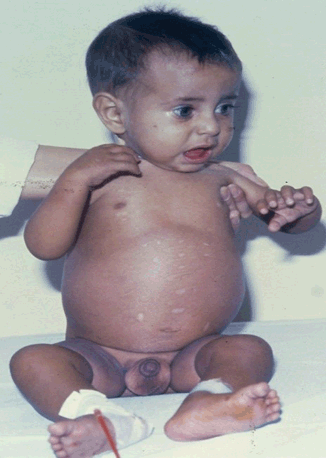Fig. 32.1
Rectal biopsy showing ganglion cells
1.
Submucosa level (Meissner’s plexus)
2.
Myenteric level (Auerbach’s Plexus)
The lack of these ganglion cells leads to failure of the distal colon to relax which results in progressive functional constipation .
The disease can affect varying lengths of bowel segment.
In 75 % of cases, the rectosigmoid area is involved.
In 15–20 %, the aganglionosis extends variably to the rest of the colon.
In the most severe cases (5–10 %), the entire colon is affected. This condition is known as total colonic aganglionosis, or TCA.
In extremely rare cases, the entire intestinal tract (< 1 %) can be affected (total intestinal aganglionosis) .
Patients with HD are prone to develop enterocolitis .
Etiology
The exact cause of HD is not known and several factors have been incriminated .
It is multifactorial, and can be familial or develop spontaneously.
The most accepted theory is that HD is due to a defect in the craniocaudal migration of enteric ganglia which are derived from the neural crest cells that occur during the first 12 weeks of gestation.
It is more common in boys than girls (male to female ratio: 3:1 or 4:1).
Family history in 3–7 % of cases.
There is increased risk for HD with affected sibling.
1.
Boys with sibling affected: 3–5 %.
2.
Girls with sibling affected: 1 %.
3.
The risk is substantially higher (12–30 %) in siblings of children with total colonic HD.
Eight genomes have been associated with HD. The predominantly affected gene is Ret-proto oncogene on chromosome 10q11.2 which affects 50 % of familial and 20 % of sporadic cases.
HD is associated with other chromosomal abnormalities and syndromes such as trisomy 21 and multiple endocrine neoplasia IIa (MEN IIa) .
Environmental factors, intrauterine intestinal ischemia, and infectious etiology have also been incriminated.
Symptoms and Signs
Signs and symptoms of HD may vary with the severity of the condition .
Symptoms range from early presentation with neonatal intestinal obstruction to chronic progressive constipation in older children.
Approximately 80 % of patients present in the first few months of life with constipation, poor feeding, and abdominal distention (Fig. 32.2).

Fig. 32.2
Clinical photograph of a patient with HD showing abdominal distension
Up to 90 % of infants with Hirschsprung’s disease fail to pass meconium in the first 24 h of life.
Signs and symptoms of neonatal presentation may include:
Failure to pass meconium within the first or second day of life
Poor feeding
Bilious vomiting
Infrequent, explosive bowel movements
Progressive abdominal distention
Poor weight gain
Enterocolitis-associated diarrhea
HD at other times may not be apparent until the baby becomes a teenager or rarely an adult.
Symptoms in older children include:
Chronic progressive constipation
Fecal impaction
Absence of soiling or overflow incontinence
Malnutrition
Failure to thrive
Abdominal distension
Patients may present with enterocolitis, a serious infection with diarrhea, fever and vomiting, and sometimes a dangerous dilatation of the colon .
Enterocolitis
Enterocolitis is a serious infection that accounts for significant morbidity and mortality in patients with Hirschsprung’s disease .
Occurs in 10–30 % of infants with Hirschsprung’s disease.
It may occur in both the aganglionic and ganglionic segments of intestines and so it is seen both preoperatively and postoperatively.
Infants should continue to be monitored closely for enterocolitis many years after corrective surgery because the infection has been reported to occur up to 10 years postoperatively.
However, most postoperative enterocolitis cases occur within the first 2 years of pull-through.
Contrast enemas should be avoided in patients with enterocolitis because of the risk of perforation.
Symptoms of enterocolitis in patients with Hirschsprung’s disease include:
Abdominal distention
Foul-smelling, watery diarrhea
Lethargy, fever, vomiting, and poor feeding
Enterocolitis should be treated aggressively as it may lead to shock and death.
Treatment includes:
Nothing by mouth.
Rectal irrigation several times a day.
Antibiotics.
Oral metronidazole (Flagyl) can be used alone with rectal irrigation in patients with mild enterocolitis.
More severe cases should be treated with intravenous broad-spectrum antibiotics and rectal irrigation.
If there is no response, a diversion colostomy may become necessary .
Associated Anomalies
Approximately 20 % of infants with HD will have one or more associated abnormality involving the neurological, cardiovascular, urological, or gastrointestinal system .
Down’s syndrome (trisomy 21) is the most common chromosomal abnormality associated with the disease, accounting for approximately 10 % of patients.
Hirschsprung’s disease has been found to be associated with the following syndromes and general anomalies:
1.
Down’s syndrome
2.
Neurocristopathy syndromes
3.
Waardenburg–Shah syndrome
4.
Yemenite deaf–blind syndrome
5.
Piebaldism
6.
Goldberg–Shprintzen syndrome
7.
Multiple endocrine neoplasia type II
8.
Congenital central hypoventilation syndrome (Ondine’s Curse)
Associated anomalies include :
Bladder diveticulum, congenital deafness, cryptorchidism, hydrocephalus, imperforate anus, Meckel’s diverticulum, neuroblastoma, renal agenesis, ventricular septal defect, pheochromocytoma, and meningomyelocele
Stay updated, free articles. Join our Telegram channel

Full access? Get Clinical Tree


